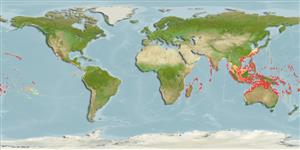Common names from other countries
>
Holocentriformes (Squirrelfishes, soldierfishes) >
Holocentridae (Squirrelfishes, soldierfishes) > Myripristinae
Etymology: Myripristis: Greek, myros, -ou = male of morey eel + Greek, pristis = saw (Ref. 45335).
More on authors: Jordan & Evermann.
Environment: milieu / climate zone / depth range / distribution range
экология
морской ассоциированный с рифами; пределы глубины 0 - 159 m (Ref. 90102), usually 3 - 15 m (Ref. 4201). Tropical; 32°N - 32°S
Indo-Pacific and Eastern Pacific: East Africa south to Natal, South Africa (but not from the Red Sea) and east to the Clipperton, Cocos and Galapagos islands, north to the Ryukyu Islands and south to the Great Barrier Reef, Norfolk Island, and Lord Howe Island. Throughout Micronesia (Ref. 1602) and common throughout Oceania, being clearly absent only from Easter Island.
Size / Вес / Возраст
Maturity: Lm ? range ? - ? cm
Max length : 30.0 cm TL самец/пол неопределен; (Ref. 4201); common length : 22.0 cm TL самец/пол неопределен; (Ref. 30573)
колючие лучи спинного плавника (общее число) : 11; членистые (мягкие) лучи спинного плавника (общее число) : 13 - 15; колючие лучи анального плавника: 4; членистые (мягкие) лучи анального плавника: 11 - 13. Lower jaw of adults prominently projecting when mouth is closed. Lower half to three-fourths of inner pectoral axil with small scales. Centers of scales silvery pink to pale yellowish, the edges red; black of opercular membrane extending below opercular spine; naked part of pectoral axil black; outer half of spinous dorsal fin yellow to orange-yellow, lower half of remaining fins red, the leading edges white, sometimes with a black submarginal streak.
Inhabits caves and hides under ledges of subtidal reef flats, channels and margins to outer reef slopes (Ref. 9710, 58302). Benthopelagic (Ref. 58302). Occurs in loose aggregations (Ref. 9710). Feeds mainly on plankton such as crab larvae. Almost always caught at night (Ref. 9307). Marketed fresh (Ref. 9307). Minimum depth reported taken from Ref. 128797.
Life cycle and mating behavior
Maturities | размножение | Spawnings | Egg(s) | Fecundities | личинки
Randall, J.E. and D.W. Greenfield, 1996. Revision of the Indo-Pacific holocentrid fishes of the genus Myripristis, with descriptions of three new species. Indo-Pac. Fish. (25):61 p. (Ref. 12419)
Статус Красного Списка МСОП (Ref. 130435)
CITES (Ref. 128078)
Not Evaluated
Угроза для людей
Harmless
Использование человеком
рыболовство: коммерческий; аквариум: коммерческий
дополнительная информация
инструменты
Специальные отчеты
Скачать в формате XML
ресурсы в Интернет
Estimates based on models
Preferred temperature (Ref.
115969): 24.7 - 29.2, mean 28.2 (based on 3413 cells).
Phylogenetic diversity index (Ref.
82804): PD
50 = 0.5000 [Uniqueness, from 0.5 = low to 2.0 = high].
Bayesian length-weight: a=0.01995 (0.01609 - 0.02475), b=3.01 (2.96 - 3.06), in cm Total Length, based on LWR estimates for this species (Ref.
93245).
Trophic level (Ref.
69278): 3.7 ±0.57 se; based on food items.
устойчивость к внешним воздействиям (Ref.
120179): высокий, минимальное время удвоения популяции до 15 месяцев (Preliminary K or Fecundity.).
Fishing Vulnerability (Ref.
59153): Low vulnerability (20 of 100).
